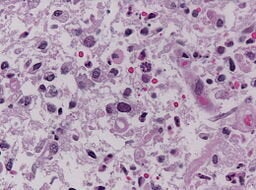
*Bo Shiun Lai [2013] is a Gates Cambridge Scholar pursuing a PhD in Pathology at the University of Cambridge. He helped develop a new paradigm that can deliver antiparasitic agents across multiple membrane barriers and published his findings on the Proceedings of the National Academy of Sciences USA. Picture of cerebral toxoplasmosis courtesy of Jensflorian and Wiki Commons.
Rare disease is commonly defined strictly by its prevalence in a given population. For instance, a disease is considered rare if it affects less than one in 1,500 individuals in the United States or one in 2,000 in Europe. However, the current definition of disease rarity is not only overly simplistic, but also an obstacle to understanding uncommon health conditions. A closer look at just one rare disease reveals a need to question the definition of disease rarity and be mindful of its limitations.
Infection versus disease
Perhaps no other rare disease has been as oversimplified as toxoplasmosis. Toxoplasmosis is a disease caused by a parasite called Toxoplasma gondii. When a pregnant woman acquires this parasite for the first time during pregnancy, it can be transmitted to her foetus congenitally. This mode of transmission results in severe defects in the eyes and brains. Because congenital toxoplasmosis only affects one in 5,000 newborns in the US by some estimates, it is considered a rare disease.
Although toxoplasmosis may be rare, its disease-causing agent is not. In fact, over two billion people worldwide, including a quarter of the American population, harbour the parasite. What becomes apparent is that the current definition of rare disease makes an implicit distinction between infection and disease since infection by a disease-causing microbe does not automatically engender disease. However, while largely dormant, innocuous and asymptomatic in healthy adults, the T. gondii parasite may take advantage of a weakened immune system, emerge from quiescence and cause opportunistic infections, which ultimately result in full-blown toxoplasmosis. Even though the majority of the two billion infected individuals are healthy, they remain susceptible to T. gondii infections. It turns out that the T. gondii parasite may also affect infected individuals' behaviour and personality. Recent studies suggest a causal relationship between dormant T. gondii parasite and psychological disorders, including schizophrenia.
By neglecting all of this, current ideas of what it means for a disease to be rare impedes our appreciation of the complexity and magnitude of the disease.
Limitations of the current understanding of rare disease
Moreover, basing decisions about the prevalence of a disease solely on how it affects the human population may downplay the problems it causes by failing to take into account its pervasiveness in other species and understating its true economic cost to society.
Toxoplasmosis, for example, affects nearly every warm-blooded animals, including all commercial livestock. It is the leading cause of abortion in sheep and goats. In 1996, toxoplasmosis alone cost the American agricultural industry $7.7 billion, an amount representing 10% of the country's agricultural Growth Domestic Product at that time.
There may be more to a rare disease than meets the eye so it is imperative not to confine our perception of an uncommon health condition solely to the number of patients who have the disease and be aware of the complexity, magnitude and the true economic cost of that disease.
